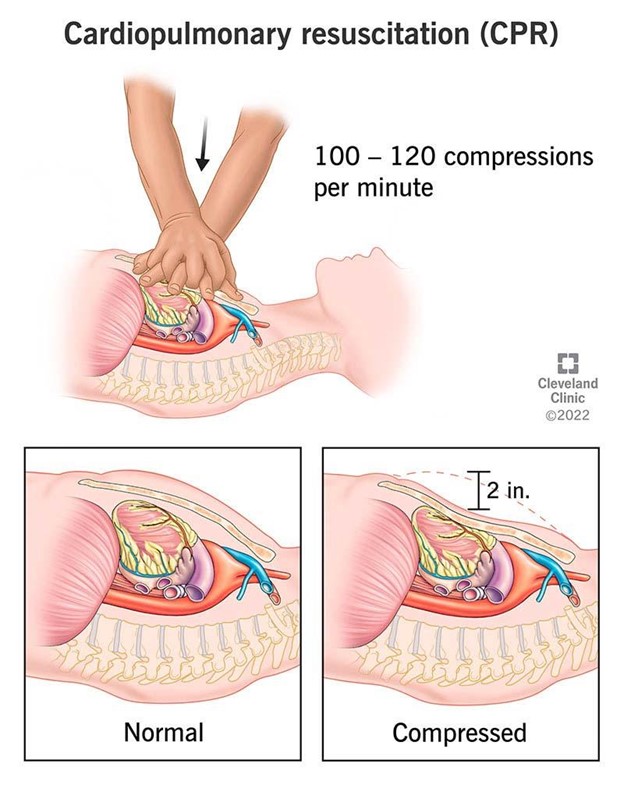Cardiopulmonary Resuscitation (CPR) and Automated External Defibrillator (AED)
CPR is a basic emergency procedure for life support that consists of chest compressions and rescue breaths. It is performed when a person’s heart stops beating or when they are not breathing normally.
AED is a device that delivers an electric shock to the heart to restore its normal rhythm. It is used when a person’s heart stops beating due to ventricular fibrillation (VF) or ventricular tachycardia (VT).
The steps for performing CPR and using AED are:
- Check for responsiveness: Tap the person’s shoulder and shout “Are you OK?” If they do not respond,
- Call for help: Call 911 or activate EMS and get an AED if available
- Open the airway: Tilt their head back and lift their chin up
- Check for breathing: Look, listen, and feel for signs of breathing for no more than 10 seconds. If they are not breathing normally,
- Give two breaths: Pinch their nose shut and seal your mouth over theirs. Blow into their mouth for one second and watch their chest rise. Give another breath and let their chest fall.
- Check for pulse: Feel for a carotid pulse in an adult or a brachial pulse in a child or infant for no more than 10 seconds. If they have no pulse or you are not sure,
- Start chest compressions: Place the heel of one hand on the center of their chest and the other hand on top. Push hard and fast at a rate of 100 to 120 compressions per minute and a depth of at least 2 inches for an adult, 2 inches for a child, or 1.5 inches for an infant. Allow the chest to recoil fully after each compression.
- Continue CPR: Follow the ratio of 30 compressions to 2 breaths for all ages. If you are alone, perform five cycles of CPR (about two minutes) before leaving to get help or an AED. If you have an AED, use it as soon as possible.
- Use AED: Turn on the AED and follow the voice prompts. Attach the pads to the person’s bare chest as shown on the diagram. Make sure no one is touching the person and say “Clear!” Press the analyze button and let the AED check the person’s heart rhythm. If the AED advises a shock, make sure no one is touching the person and say “Clear!” Press the shock button and deliver the shock. If the AED does not advise a shock, resume CPR immediately.
- Repeat until help arrives: Continue CPR and use AED until the person shows signs of life, such as breathing, coughing, or moving; trained medical personnel take over; you are too exhausted to continue; or the scene becomes unsafe.

Nursing Test Bank
Quiz #1: RN Exams Pharmacology Exams
Quiz #2: RN Exams Medical-Surgical Exams
Quiz #3: RN Exams Fundamentals Exams
Quiz #4: RN Exams Maternal-Newborn Exams
Quiz #5: RN Exams Anatomy and Physiology Exams
Quiz #6: RN Exams Obstetrics and Pediatrics Exams
Quiz #7: RN Exams Fluid and Electrolytes Exams
Quiz #8: RN Exams Community Health Exams
Quiz #9: RN Exams Promoting Health across the lifespan Exams
Quiz #10: RN Exams Multidimensional care Exams
Naxlex Comprehensive Predictor Exams
Quiz #1: Naxlex RN Comprehensive online practice 2019 B with NGN
Quiz #2: Naxlex RN Comprehensive Predictor 2023
Quiz #3: Naxlex RN Comprehensive Predictor 2023 Exit Exam A
Quiz #4: Naxlex HESI Exit LPN Exam
Quiz #5: Naxlex PN Comprehensive Predictor PN 2020
Quiz #6: Naxlex VATI PN Comprehensive Predictor 2020
Quiz #8: Naxlex PN Comprehensive Predictor 2023 - Exam 1
Quiz #10: Naxlex HESI PN Exit exam
Quiz #11: Naxlex HESI PN EXIT Exam 2
Questions on Cardiopulmonary Resuscitation (CPR) and Automated External Defibrillator (AED)
Correct Answer is C
Explanation
<p>Reason: This choice is incorrect because giving two breaths after every 50 compressions would delay the ventilation too long and cause hypoxia.</p>
Correct Answer is ["A","B"]
Explanation
<p>Choice E Reason: This choice is incorrect because it places one pad on the lower left side above the hip, which is too far from the heart and may interfere with pelvic organs.</p>
Correct Answer is B
Explanation
<p>Reason: This choice is incorrect because it describes the location of the popliteal artery, which is not used to check for a pulse in CPR.</p>
<p>Reason: This choice is incorrect because it indicates that the AED has detected a normal rhythm and advises the nurse to check for breathing and give oxygen if needed.</p>
<p>Reason: This choice is incorrect because compressing the chest at a rate of 120 to 140 compressions per minute is too fast and may not allow the chest to recoil fully after each compression.</p>
Search Here
Related Topics
More on Nursing
Free Nursing Study Materials
Access to all study guides and practice questions for nursing for free.
- Free Nursing Study Trials
- Free Nursing Video tutorials
- Free Nursing Practice Tests
- Free Exam and Study Modes
- Free Nursing Revision Quizlets
